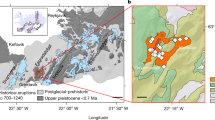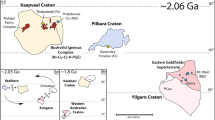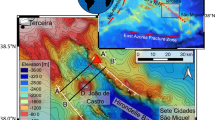Abstract
Flood basalts appear to form during the initiation of hotspot magmatism. The Columbia River basalts (CRB) represent the largest volume of flood basalts associated with the Yellowstone hotspot, yet their source appears to be in the vicinity of the Wallowa Mountains1, about 500 km north of the projected hotspot track. These mountains are composed of a large granitic pluton intruded into a region of oceanic lithosphere affinity2. The elevation of the interface between Columbia River basalts and other geological formations indicates that mild pre-eruptive subsidence took place in the Wallowa Mountains, followed by syn-eruptive uplift of several hundred metres and a long-term uplift of about 2 km. The mapped surface uplift mimics regional topography, with the Wallowa Mountains in the centre of a ‘bull's eye’ pattern of valleys and low-elevation mountains. Here we present the seismic velocity structure of the mantle underlying this region and erosion-corrected elevation maps of lava flows, and show that an area of reduced mantle melt content coincides with the 200-km-wide topographic uplift. We conclude that convective downwelling and detachment of a compositionally dense plutonic root can explain the timing and magnitude of Columbia River basalt magmatism, as well as the surface uplift and existence of the observed melt-depleted mantle.
This is a preview of subscription content, access via your institution
Access options
Subscribe to this journal
Receive 51 print issues and online access
$199.00 per year
only $3.90 per issue
Buy this article
- Purchase on Springer Link
- Instant access to full article PDF
Prices may be subject to local taxes which are calculated during checkout



Similar content being viewed by others
References
Camp, V. E. & Ross, M. E. Mantle dynamics and genesis of mafic magmatism in the intermontane Pacific Northwest. J. Geophys. Res. 109, doi:10.1029/2003JB002838 (2004)
Lallemant, H. G. A. Pre-Cretaceous tectonic evolution of the Blue Mountains province, northeastern Oregon. USGS Prof. Pap. 1438, 271–304 (1994)
Camp, V. E., Ross, M. E. & Hanson, W. E. Genesis of flood basalts and basin and range volcanic rocks from Steens Mountain to the Malheur River Gorge, Oregon. Geol. Soc. Am. Bull. 115, 105–128 (2003)
Jordan, B. T. in Plumes, Plates and Paradigms (eds Foulger, G. R., Natland, J. H., Presnall, D. C. & Anderson, D. L.) 503–515 (Geological Society of America Memoir 388, Boulder, Colorado, 2005)
Dodson, A., Kennedy, M. B. & De Paolo, D. J. Helium and neon isotopes in the Imnaha Basalt, CRBG, evidence for a Yellowstone plume source. Earth Planet. Sci. Lett. 150, 443–451 (1997)
Anderson, D. L. The sublithospheric mantle as the source of continental flood basalts; the case against the continental lithosphere and plume head reservoirs. Earth Planet. Sci. Lett. 123, 269–280 (1994)
Wells, R. E., Weaver, C. S. & Blakely, R. J. Fore-arc migration in Cascadia and its neotectonic significance. Geology 26, 759–762 (1998)
McCaffrey, R. et al. Rotation and plate locking at the southern Cascadia subduction zone. Geophys. Res. Lett. 27, 3117–3120 (2000)
Hooper, P. R. The Columbia River flood basalt province: current status. Geophys. Monogr. 100, 1–27 (1997)
Hooper, P. R. & Camp, V. E. Deformation of the southeast part of the Columbia plateau. Geology 9, 323–328 (1981)
Camp, V. E. & Hooper, P. R. Geologic studies of the Columbia Plateau. Part 1. Late Cenozoic evolution of the southeastern part of the Columbia River basalt province. Geol. Soc. Am. Bull. 92, 659–668 (1981)
Hooper, P. R. & Conrey, R. M. A model for the tectonic setting of the Columbia River basalt eruptions. Geol. Soc. Am. (Spec. Pap.) 239, 293–306 (1989)
Goles, G. G. Miocene basalts of the Blue Mountains province in Oregon. I. Compositional types and their geological settings. J. Petrol. 27, 495–520 (1986)
Walker, G. W. Reconnaissance Geologic Map of the Oregon Part of the Grangeville Quadrangle, Baker, Union, Umatilla, and Wallowa Counties, Oregon Map (USGS Misc. Investigations Series I-1116, 1979).
Reidel, S. P., Hooper, P. R., Webster, G. D. & Camp, V. E. Geologic Map of Southeastern Asotin County, Washington (Washington Division of Geology and Earth Resources Map Series, GM-40, 1992).
Hooper, P. R., Webster, G. D. & Camp, V. E. Geologic Map of the Clarkson 15 Minute Quadrangle, Idaho and Washington (Washington Division of Geology and Earth Resources Map Serie GM-31, 1985).
Lambeck, K. Geophysical Geodesy: the Slow Deformations of the Earth Ch. 10 (Clarendon, Oxford, 1988)
Anderson, R. S. Evolution of the Santa Cruz Mountains, California, through tectonic growth and geomorphic decay. J. Geophys. Res. 99, 20161–20179 (1994)
Camp, V. E. Geologic studies of the Columbia Plateau: Part II. Upper Miocene basalt distribution, reflecting source locations, tectonism, and drainage history in the Clearwater embayment Idaho. Geol. Soc. Am. Bull. 92, 669–678 (1981)
Reidel, S. P. et al. The Grande Ronde Basalt, Columbia River Basalt Group; Stratigraphic descriptions and correlations in Washington, Oregon, and Idaho. Geol. Soc. Am. (Spec. Pap.) 239, 21–54 (1989)
Tolan, T. L. et al. Revisions to the estimates of the areal extent and volume of the Columbia River Basalt Group. Geol. Soc. Am. (Spec. Pap.) 239, 1–20 (1989)
Saltzer, R. L. & Humphreys, E. D. Upper mantle P-wave structure of the eastern Snake River Plain and its relationship to geodynamic models of the region. J. Geophys. Res. 102, 11829–11841 (1997)
Hammond, W. C. & Humphreys, E. D. Upper mantle seismic wave velocity: The effect of realistic partial melt geometries. J. Geophys. Res. 105, 10975–10999 (2000)
Schutt, D. L. & Lesher, C. E. The effect and seismic velocity of garnet and spinel lherzolite. J. Geophys. Res. (in the press)
Elkins-Tanton, L. T. & Hager, B. H. Melt intrusion as a trigger for lithospheric foundering and the eruption of the Siberian flood basalts. Geophys. Res. Lett. 27, 3937–3940 (2000)
Saleeby, J. B. & Foster, Z. Topographic response to mantle lithosphere removal in the southern Sierra Nevada region, California. Geology 32, 245–248 (2004)
Armstrong, R. L., Taubeneck, W. H. & Hales, P. O. Rb-Sr and K-Ar geochronometry of Mesozoic granitic rocks and their Sr isotopic composition, Oregon, Washington and Idaho. Geol. Soc. Am. Bull. 88, 387–411 (1977)
Acknowledgements
We thank G. Goles for initial conversations regarding this manuscript. Funding for this work provided by National Science Foundation grants to J.J.R. and E.D.H. A review from M. Richards improved the manuscript. We thank J. Riker, D. Clippinger, C. Simmons and M. Giba for field assistance. We also thank N. Fay and J. Crosswhite for help with numerical analysis.
Author information
Authors and Affiliations
Corresponding author
Ethics declarations
Competing interests
Reprints and permissions information is available at npg.nature.com/reprintsandpermissions. The authors declare no competing financial interests.
Supplementary information
Supplementary Figure 1
Digital elevation models showing the elevation of each surface interpolated from the current mapped extent of flow interfaces (black dots). The overlapping extent of each flow was then using areas that were well constrained with data and published thicknesses to create a composite surface (Fig 2). Dashed lines show the locations of cross sections. (PDF 2223 kb)
Rights and permissions
About this article
Cite this article
Hales, T., Abt, D., Humphreys, E. et al. A lithospheric instability origin for Columbia River flood basalts and Wallowa Mountains uplift in northeast Oregon. Nature 438, 842–845 (2005). https://doi.org/10.1038/nature04313
Received:
Accepted:
Issue Date:
DOI: https://doi.org/10.1038/nature04313
This article is cited by
-
Progress in the numerical modeling of mantle plumes
Science China Earth Sciences (2023)
-
Do Supercontinent-Superplume Cycles Control the Growth and Evolution of Continental Crust?
Journal of Earth Science (2020)
-
Western US volcanism due to intruding oceanic mantle driven by ancient Farallon slabs
Nature Geoscience (2018)
-
Low-buoyancy thermochemical plumes resolve controversy of classical mantle plume concept
Nature Communications (2015)
-
Geochemical evolution of southern Red Sea and Yemen flood volcanism: evidence for mantle heterogeneity
Arabian Journal of Geosciences (2014)
Comments
By submitting a comment you agree to abide by our Terms and Community Guidelines. If you find something abusive or that does not comply with our terms or guidelines please flag it as inappropriate.



